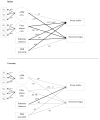Inhibitory control effects in adolescent binge eating and consumption of sugar-sweetened beverages and snacks
- PMID: 24949566
- PMCID: PMC4127340
- DOI: 10.1016/j.appet.2014.06.013
Inhibitory control effects in adolescent binge eating and consumption of sugar-sweetened beverages and snacks
Abstract
Inhibitory control and sensitivity to reward are relevant to the food choices individuals make frequently. An imbalance of these systems can lead to deficits in decision-making that are relevant to food ingestion. This study evaluated the relationship between dietary behaviors - binge eating and consumption of sweetened beverages and snacks - and behavioral control processes among 198 adolescents, ages 14 to 17. Neurocognitive control processes were assessed with the Iowa Gambling Task (IGT), a generic Go/No-Go task, and a food-specific Go/No-Go task. The food-specific version directly ties the task to food cues that trigger responses, addressing an integral link between cue-habit processes. Diet was assessed with self-administered food frequency and binge eating questionnaires. Latent variable models revealed marked gender differences. Inhibitory problems on the food-specific and generic Go/No-Go tasks were significantly correlated with binge eating only in females, whereas inhibitory problems measured with these tasks were the strongest correlates of sweet snack consumption in males. Higher BMI percentile and sedentary behavior also predicted binge eating in females and sweet snack consumption in males. Inhibitory problems on the generic Go/No-Go, poorer affective decision-making on the IGT, and sedentary behavior were associated with sweetened beverage consumption in males, but not females. The food-specific Go/No-Go was not predictive in models evaluating sweetened beverage consumption, providing some initial discriminant validity for the task, which consisted of sweet/fatty snacks as no-go signals and no sugar-sweetened beverage signals. This work extends research findings, revealing gender differences in inhibitory function relevant to behavioral control. Further, the findings contribute to research implicating the relevance of cues in habitual behaviors and their relationship to snack food consumption in an understudied population of diverse adolescents not receiving treatment for eating disorders.
Keywords: Adolescents; Binge eating; Cue effects; Impulsivity; Inhibitory control; Sweetened snacks.
Copyright © 2014 Elsevier Ltd. All rights reserved.
Conflict of interest statement
Figures



References
-
- Abroms L, Jorgensen C, Southwell B, Geller A, Emmons K. Gender differences in young adults’ beliefs about sunscreen use. Health Education & Behavior. 2003;30(1):29–43. - PubMed
-
- Ames SL, Grenard JL, Thush C, Sussman S, Wiers RW, Stacy AW. Comparison of indirect assessments of association as predictors of marijuana use among at-risk adolescents. Experimental & Clinical Psychopharmacology. 2007;15(2):204–18. doi: 10.1037/1064-1297.15.2.218. 2007-05127-009 [pii] - DOI - PMC - PubMed
-
- Aron AR, Poldrack RA. The cognitive neuroscience of response inhibition: Relevance for genetic research in attention-deficit/hyperactivity disorder. Biological Psychiatry. 2005;57(11):1285–92. - PubMed
-
- Bechara A, Van der Linden M. Decision-making and impulse control after frontal lobe injuries. Current Opinion in Neurology. 2005;18:734–739. - PubMed
Publication types
MeSH terms
Substances
Grants and funding
LinkOut - more resources
Full Text Sources
Other Literature Sources

